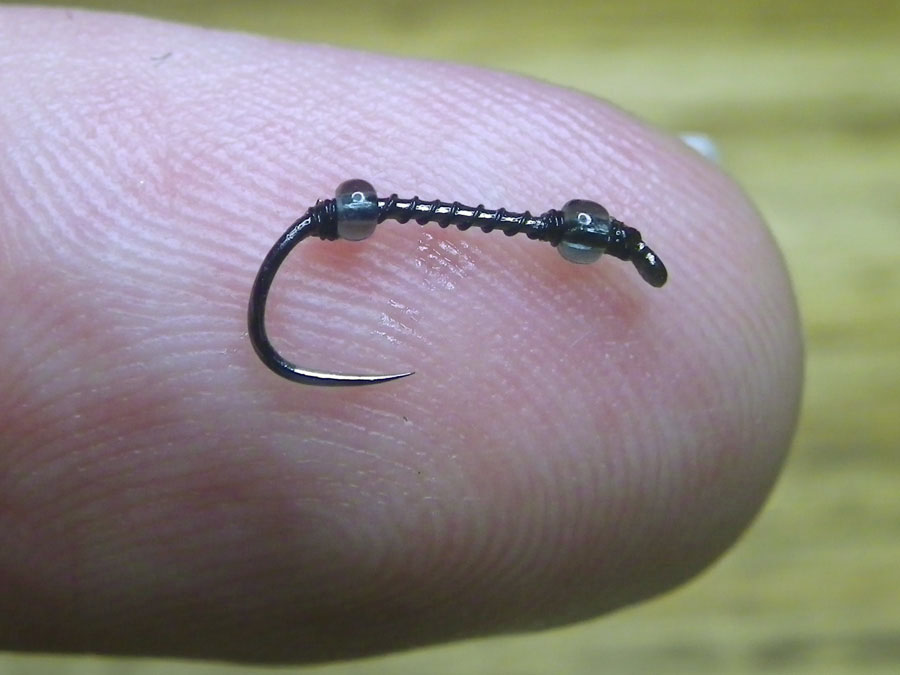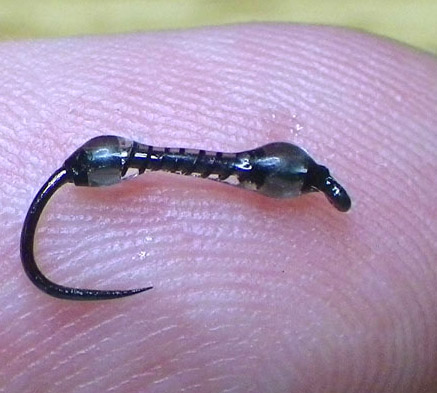On the third and 26th of October two articles were posted on this website which looked at the role which the new generation of UV light-cured acrylic resins was playing in devising an effective larval imitation of one of our most prolific sub-aquatic insects, the black fly.
http://www.tomsutcliffe.co.za/fly-fishing/friend-s-articles/item/957-black-fly-%E2%80%93-the-challenge-by-ed-herbst.html
http://www.tomsutcliffe.co.za/fly-fishing/friend-s-articles/item/967-the-black-fly-challenge-%E2%80%93-a-postscript-ed-herbst-writes.html
The articles generated some interest although the consensus in KZN is that black fly are less prevalent in the streams of the Drakensberg mountain range in Natal than they are in the Western Cape.
Tom Sutcliffe then forwarded me an email from Riaan Theart, one of the subscribers to his Spirit of Fly Fishing newsletter.
Riaan fishes a trout dam in the in the Royal Natal National Park in the KZN Drakensberg region and wanted details of how to tie the Simulid Nymph. I sent him the instructions below and the two photographs showing the construction of the fly before and after the application of the UV light-cured acrylic resin. Riaan caught seven fine trout on his version of the fly which seems to be as effective on dams as it is on streams. Presumably they took the fly either as a chironomid pupa or a drowned ant because black fly larvae are found mainly in the swiftest of currents.
Click in images to enlarge

Riaan Theart’s trout caught on a Natal dam
I then received an email from another Simulid Nymph fan, Dawid Rossouw, whose photo essay on a family trip to kayak the Orange River in the Richtersveld in search of yellowfish was recently featured on this website.
http://www.tomsutcliffe.co.za/fly-fishing/friend-s-articles/item/970-fly-fishing-for-richtersveld-yellows-by-dawid-rossouw.html
“I spent a morning on Elandspad Beat 3 and caught about 20 fish. Most were caught on smallish Adams and RAB dries, but about a third of the fish took your black fly nymph. I fished it on a dropper, New Zealand style. I attach a picture for you.”

Dawid Rossouw’s trout caught on the Elandspad
Subsequently, I received an email from split cane rod builder Stephen Dugmore who also fished the fly New Zealand-style below a Para RAB on the Elandspad: “The trout ate it like a mielie. Definitely my go-to nymph from now on. Photograph attached.”

Stephen Dugmore’s Elandspad rainbow, also caught on the Simulid Nymph
The first field test of the Simulid in the Rhodes area was conducted by Capetonian Herman Potgieter who fished it on a 6 foot Stephen Boshoff split cane rod on the upper reaches of the Bell River near the summit of the Naudes Nek Pass which links Rhodes and Maclear. “I fished it on a dropper, New Zealand-style, below Elk Hair Caddis variations and the trout took both dry and dropper with equal enthusiasm. It is a very streamlined fly so it is easy to cast accurately. Being streamlined it sinks quickly but it is light enough not to quickly submerge the top fly. It lands softly and really looks good under water. I was surprised at the way the fish target it even in faster, turbulent runs. Sometimes the fish would rise for the surface fly, turn away and then see the Simulid and take it. I was twice broken by bigger fish which shot out from the undercut banks to take the nymph. What is striking in the underwater photographs is the translucence of the pattern and the way that light shines through the epoxy coating to highlight the contrasting internal colour of the hook shank and the wire ribbing. I was using the glass bead version of the fly but it is a very versatile design and if you are fishing deeper runs or swifter currents you can use1.5 mm brass or tungsten beads and suspend the heavier version beneath a bigger more buoyant fly such as a DDD. It has certainly earned a permanent place in my fly box.”

High altitude trout. The upper reaches of the Bell River midway between Rhodes and Maclear where Herman Potgieter fished the Simulid Nymph.

One of Herman’s trout showing the contrast between the inner and outer layers of the fly.
I am assuming that the stream fish caught on this fly by Tom Sutcliffe, Dawid Rossouw, Stephen Dugmore and Herman Potgieter are taking it as a black fly larva or possibly a drowned ant – a prey image which usually solicits an instant response from trout in dams and rivers. However there is another intriguing possibility – are chironomids present in any significant numbers in our mountain streams? Conventional stillwater wisdom is that they are found where there are silt beds because that is the preferred habitat of buzzer larvae – the bloodworm. It was John Goddard who first alerted fly fishers to the fact that river trout would take a #18 Suspender Buzzer, particularly in the early evening.
In 1994, while fishing the Elandspad, I met Rebecca Tharme who was working on a doctoral thesis at the University of Cape Town. I asked her to give me a percentage breakdown of the number of aquatic insects per square metre of stream bed substrate and the results surprised me. I expected Baetis nymphs to dominate and they did – by a tiny margin - 4542 which made up 36.2 % of the total. Chironomids were almost identical in numbers, 4382 which made up 34.9% of the total. The notes she sent me specifically mentioned chronomids, not diptera and, in any case, the larvae of both black fly and net wing midges are found on the surface of stream bed rocks and not in the substrate.
She said that the chironomids were deep in the substrate and not accessible to trout.
However, they do have to emerge and most chironomids do so at dusk – so it could be that emerging buzzer pupa are common occurrence in our streams but that they are vulnerable to predation by trout when most anglers are no longer on the stream.
I have sent examples of the pattern and kits containing the necessary hooks, wire, beads and UV torches and resin to several fly fishers in Barkly East, Rhodes and Ugie with the request that they test the Simulid Nymph in that area of the North Eastern Cape Drakensberg mountain range and let me know how they fare.
Simulid Nymph dressing
- Size 16 barbless (Grip 11011 BL, TMC 103 BL, Mouche 8426, Partridge SLD, Hanak 130 BL, Dohiku 301)
Thread Black UTC Ultra Wire, extra small, held in place by superglue
Body 11/0 glass Rocaille seed bead (pronounced ‘roh kai’) or 1.5 mm brass or tungsten. One is placed at the eye and another at the bend of the hook. They are held in place by the wire and then covered by UV photo-cured resin in an hourglass shape to mimic the larva which, with its bulbous abdomen, has the profile of a bowling skittle.
1 Put a dab of superglue behind the hook eye and tie in a few turns of wire. Break off the wire.
2 Slide the bead onto the hook and up against the wire at the hook eye.
3 Cover the hook shank with a thin coat of superglue and, starting above the barb, wrap turns of wire towards the back of the bead at the hook eye and build up a few turns of wire behind the bead. There must be a small gap between each turn of wire so that the hook shank can be seen. (This adds depth to the fly body which, on the completed fly contains three visible layers – hook, wire and the resin coating.) Break or cut the wire at the bead and at the bend of the hook.
4 Take the hook out of the vise and slide a second bead onto the hook so that it butts against the wire body on the hook shank.
5 Apply a tiny dab of superglue behind the bead at the bend of the hook and apply a few wraps of wire before cutting the wire away.
6 Cover the beads with UV resin and cure. Then cover the central section of the Shook shank between the beads with UV resin to create a Coke bottle shape and cure with your UV torch. Do not make the centre section too narrow otherwise the resulting pattern will look more like a sunken ant than a simulid larva.


Two stages of the Simulid Nymph’s “construction”
Some resins remain slightly tacky after curing but this can be countered by using acetone on an ear bud and then putting them in the sun to dry. There is very little to choose between them although the consensus seems to be that the Deer Creek resin and torch (a laser apparently) are marginally better than the others. Both Loon and Clear Cure Goo have introduced more powerful UV torches recently. All these lights come with the warning that they must not be shone into the eyes.
These resins have opened a new world for fly designers and the extent which that has happened was brought home to me when I saw this snail pattern on the Flyfishfood website
https://www.youtube.com/watch?v=auSPuWKOLKg
http://www.flyfishfood.com/2014/12/snail-fly-pattern.html
Up to now we have relied on patterns developed decades ago such as Tom Ivens’ Black and Peacock Spider but this, to me. seems like a far more realistic pattern.



